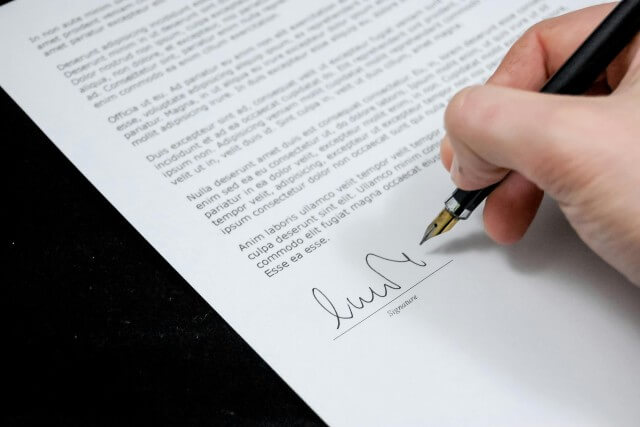Advertisement
A scholarship thank-you letter is a written message of gratitude to a contributor for their contributions. They were frequently written by the scholarship recipient to thank a generous donor or organization.
In this post, we define a scholarship thank-you letter, explain what to include, go over how to write one and provide suggestions, templates, and samples to help you create your own.

What is a Scholarship Thank-you Letter?
A scholarship thank-you letter is a formal letter of request written to a company or person that finances your education. Usually, it includes a thank-you note and an explanation of how the scholarship will advance your academic goals.
Certain institutions could mandate that you compose a letter following a specific structure in order to foster a good rapport between the university and the donating entity or person.
Advertisement
Why is Writing a Scholarship Thank-you Letter Important?
A scholarship thank-you letter can have multiple purposes, including the following:
1. Express Gratitude
It’s customary to express gratitude to the donor for a present you receive. Scholarships operate in the same way. If a scholarship enabled a recipient to continue their education, an organization or individual donor might be pleased to hear of the positive impact of their gift on a student’s life.
2. Show a Direct Impact
A contributor, whether an individual or an organization, can be interested in knowing how you intend to use their money. They could be more inclined to keep contributing to an endowment or scholarship if they are aware of the benefits of their work.
3. Develop Your Professional Network
Thanking a donor or organization in writing might strengthen your relationship with them because they might think of you in the future when you’re seeking for chances.
4. Enhance Your Writing Skills
Formal writing is required for many employment roles for correspondence and reports. You can improve your professional skills by writing a thank-you note.
Remember that you were awarded the scholarship for a specific reason, which may have been your academic prowess, financial need, or personal traits that made you stand out from the competition.
It is verified that this scholarship is significant and worthy of your time to acknowledge it professionally when you send a thank-you note.
What Should Be in a Scholarship Thank-you Letter
The following are key elements of a thank-you letter for a scholarship:
1. Statement of Appreciation
A letter’s goal should be made clear to the donor by starting with a heartfelt expression of thanks. To improve clarity and uphold formal structure, this section usually consists of one or two words and includes the complete title of the scholarship.
Remember to give greater attention to a current donation than to any previous or upcoming interactions with a donor or organization.
2. Background Information
A donor or organization can be interested in knowing more specifics regarding the receiver of their contribution. Think about including some personal background, such as your hometown and pertinent details about your experiences leading up to college.
When selecting a school and a topic of study, it could be beneficial to concentrate on experiences that were beneficial.
3. Current Status
Tell them about your achievements and activities at the moment, particularly your chosen major. You might talk about the best parts of a degree program and the ways in which it will advance your career and personal development.
Talking about a related internship or volunteer experience might demonstrate your commitment to the field even more.
To add to your academic experiences, you may write a phrase about your recent volunteer work at a beach cleanup if you’re studying environmental science.
4. Academic Goals
Determining your academic goals could be beneficial whether you’re about to start your first year of college or are a second year student. Projects you want to conduct or your field of academic interest may fall under this category.
In the event that it applies, you can also discuss your goals for a master’s or PhD. You may talk about your desire to seek a master’s in fine arts, for instance, if you’re majoring in creative writing while earning an English degree.
5. Plans for the Future
Whether you’re going to be a first-year student or a second-year student, it could be useful to outline your academic objectives. Your planned research initiatives or your field of academic interest may fall under this category.
If appropriate, you may also discuss your goals for a master’s or doctoral degree. You may talk about wanting to pursue a master’s in fine arts if, for instance, you are pursuing an English degree with a creative writing concentration.
You might talk in one or two sentences about a long-term goal for a career path, depending on your interests. If you want to work in customer service, this area can be very helpful. It could be satisfying for donors to know that their contributions would benefit your community.
For instance, if you’re studying to become a doctor, you can talk about the demographic you want to serve and the specialism you’re interested in.
How to Write a Scholarship Thank-you Letter
Here are the procedures for writing a scholarship thank-you letter:
1. Include Contact Information
If the letter is handwritten, place your contact information in the upper-left corner of the page. Included in this are your phone number, email address, return address, and full name. Put the organization’s name and mailing address underneath.
To offer an organization a chance to follow up later, if you’re sending an email, think about giving a different form of contact information.
2. Address the Donor
Address the door or organization with a formal salutation. Make sure you only use the recipient’s last name and the proper title if you are writing the letter to them.
When composing a document on behalf of a group of individuals, you have the option to replace their names with the name of the company. You may also include the complete name of the organization after “Dear members.”
3. Write an Opening Paragraph
Introduce yourself and provide some background information along with your declaration of gratitude in the opening paragraph. Depending on your preferences and the needs of the university’s scholarship department, this section can consist of one to three sentences.
Aspects about your current situation, such as your major and expected graduation year, can also be included. In order to communicate professionalism and respect, think about using polite words in this part.
4. Compose the Main Content
Describe your academic aspirations and future ambitions in the next two paragraphs. Make sure your stories contain particular details so a donor or organization may learn more about your future goals and your academic ambitions.
Think about mentioning in the letter any shared traits or values you have with the organization. You might bring up your scholarship from individuals with a particular passion, for instance, in just one statement.
5. Reiterate Your Gratitude
In the final paragraph of the thank-you note, restate your expression of thanks in a new way. Think about highlighting the ways in which the scholarship could be beneficial to many students in general.
Declaring that you will follow up with the organization later on could be beneficial. Reiterating information about your academic objectives and the university you attend is another option.
6. Include a Formal Closing
Finish the letter with a professional closing, such as “Sincerely” or “Best Regards,” and sign your name in cursive. If you’re composing a digital letter, you can sign it in a word processing tool and then upload it to the document as an image.
Make sure to provide your full name and, if necessary, give any contact information requested by the scholarship office. For example, certain universities may ask students to include an identity code.
Advertisement






